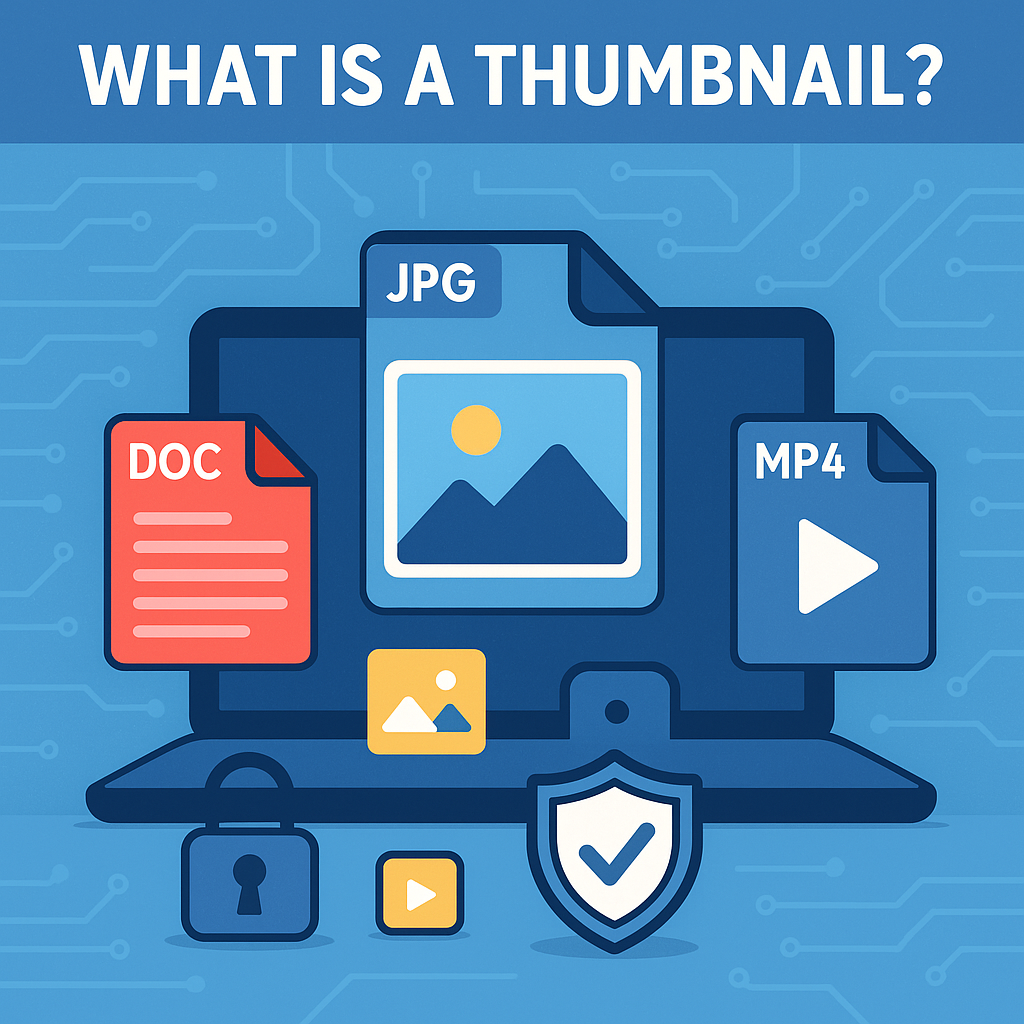What Is a Thumbnail? A Complete Guide for Tech and Cybersecurity Professionals
Updated on November 11, 2025, by Xcitium

Have you ever clicked on a YouTube video, an article, or a document because of a small image that caught your attention? That image is a thumbnail—a compact visual preview designed to represent larger content quickly. But beyond marketing and design, thumbnails also play an important role in digital security, user experience, and web optimization.
In this guide, we’ll explore what a thumbnail is, how it works, and why it matters not only for engagement but also for online safety and cybersecurity workflows. Whether you’re a cybersecurity manager, IT leader, or content strategist, understanding thumbnails can help you optimize media systems safely and effectively.
What Is a Thumbnail?
A thumbnail is a small, reduced-size version of an image, video frame, or document preview used to represent the full-sized file. Think of it as a “miniature poster” that visually summarizes the content behind it.
For example:
-
The small image preview on YouTube videos
-
Website gallery images
-
File previews in your desktop folder or cloud drive
The word “thumbnail” comes from the idea of something small enough to fit under your thumbnail, symbolizing a quick visual reference.
In simple terms:
A thumbnail helps users recognize, organize, and interact with digital content faster without loading the full file.
How Thumbnails Work
When you upload a photo, video, or document, software systems like browsers, media servers, or operating systems automatically generate a smaller copy—often resized to around 120×90 pixels for videos or 150×150 pixels for images.
These thumbnails are:
-
Cached for faster loading speeds
-
Linked to their original source files
-
Displayed in galleries, file managers, or video players
Why it matters for cybersecurity
From a security standpoint, thumbnails must be handled carefully because:
-
Malicious actors can embed malware in thumbnail files (especially in EXIF data).
-
Fake thumbnails can deceive users into downloading infected files or clicking on phishing links.
-
Thumbnails in corporate systems can leak metadata if not properly sanitized.
That’s why secure thumbnail rendering—especially in email attachments, document previews, and web applications—is critical.
Types of Thumbnails
1. Image Thumbnails
Used in websites, file systems, and image libraries to show smaller previews.
Example: Product images in e-commerce.
2. Video Thumbnails
A still frame from a video that entices users to click.
Platforms like YouTube or Vimeo allow custom thumbnail uploads to maximize engagement.
3. Document Thumbnails
Found in file explorers or content management systems (CMS) showing previews of PDFs, PowerPoints, or Word documents.
4. Website Thumbnails
Small snapshots of entire web pages displayed on search results or bookmark previews.
Each serves a different purpose but shares one common goal: to improve accessibility and speed up decision-making for users.
Why Thumbnails Are Important
1. Improves User Experience
Thumbnails give users visual cues, helping them find what they need faster without opening every file.
2. Boosts Engagement
For marketing and online platforms, compelling thumbnails increase click-through rates (CTR) and retention.
3. Saves Bandwidth and Storage
By displaying reduced-size images, thumbnails reduce server load and improve web performance.
4. Strengthens Brand Consistency
Custom thumbnails maintain brand identity across video platforms, product catalogs, and digital assets.
5. Impacts SEO and Accessibility
Optimized thumbnails improve page load speed, which is a key Google ranking factor. Proper labeling and alt-text also enhance accessibility compliance (WCAG).
6. Enhances Security Awareness
Thumbnails help cybersecurity teams visualize logs, attachments, or screenshots during incident analysis while maintaining containment to avoid executing unknown files.
Cybersecurity Implications of Thumbnails
While thumbnails seem harmless, they can become attack vectors if not secured properly. Here’s how:
1. Malicious Code Embedding
Hackers can hide malicious payloads within image metadata or thumbnail files.
Example: Steganography—a technique that conceals data within image pixels.
2. Thumbnail Cache Exploitation
Cached thumbnails can contain sensitive file previews, posing a privacy risk on shared systems or networks.
3. Phishing and Fake Previews
Cybercriminals often create fake thumbnails mimicking legitimate brands or file icons to trick users into clicking malware links.
4. Exploiting Image Libraries
Older image-handling libraries (like ImageMagick) have had vulnerabilities that allow remote code execution via crafted thumbnail files.
5. Forensics and Threat Detection
On the flip side, cybersecurity analysts use thumbnails during digital forensics to examine deleted or hidden images without restoring full files—minimizing risk of executing malicious content.
How to Secure Thumbnails in Cyber Environments
To protect your systems from thumbnail-based vulnerabilities, implement the following best practices:
1. Sanitize Uploaded Images
Strip EXIF metadata and re-encode thumbnails on secure servers before displaying them to end users.
2. Use Secure Rendering Engines
Deploy sandboxed thumbnail generators that isolate processing and prevent code execution from image data.
3. Restrict File Permissions
Limit thumbnail cache access to system processes only. Prevent external or public access to cache directories.
4. Monitor File Integrity
Use anti-malware software and file integrity monitoring tools to detect modifications in image files or thumbnail directories.
5. Enforce Content Security Policies (CSP)
CSP headers in web applications can block malicious thumbnail URLs or data injection attempts.
6. Educate Users
Train employees to recognize fake thumbnails and phishing visuals—especially in email or shared drives.
Thumbnail Optimization Best Practices (For Performance and Security)
Optimizing thumbnails involves balancing visual appeal, performance, and security.
Here’s how you can achieve it:
1. Right File Format
Use WebP or JPEG for balance between compression and quality. Avoid BMP or TIFF for web use—they’re larger and easier to manipulate.
2. Use Proper Dimensions
Standard web thumbnails:
-
Images: 150×150 or 300×300 pixels
-
Videos: 1280×720 pixels (YouTube standard)
3. Compress Responsibly
Compress images using safe tools (TinyPNG, ImageOptim) to prevent bloated file sizes.
4. Add Alt Text and Descriptive File Names
Example: cybersecurity-dashboard-thumbnail.jpg instead of IMG_12345.jpg.
5. Use HTTPS and Signed URLs
Ensure thumbnails on your platform load via secure, encrypted protocols.
6. Implement Lazy Loading
Load thumbnails only when users scroll near them to improve page speed and resource efficiency.
7. Protect Storage Buckets
For AWS or GCP environments, configure access control lists (ACLs) to restrict thumbnail viewing or editing permissions.
Thumbnails and Cloud Security
With cloud-hosted assets becoming the norm, securing thumbnail generation pipelines is more crucial than ever.
Potential Cloud Risks:
-
Misconfigured S3 buckets exposing thumbnail data
-
Public access to internal images or surveillance footage
-
Shared link abuse for malicious thumbnail hosting
Best Practices:
-
Store thumbnails in private buckets with signed URLs.
-
Encrypt at rest (AES-256) and in transit (TLS 1.3).
-
Implement API gateways with rate limiting for thumbnail access.
-
Use cloud-native malware scanning (like AWS GuardDuty or Xcitium OpenEDR integration).
AI and Thumbnails: The Future of Smart Previews
Artificial intelligence (AI) now plays a major role in thumbnail generation, selection, and analysis.
AI-Powered Use Cases:
-
Smart Video Thumbnails: AI selects high-engagement frames automatically.
-
Security Analytics: AI can detect inappropriate or malicious content in uploaded images.
-
Automated Branding: AI tools ensure all thumbnails align with your company’s color and layout standards.
Cybersecurity Integration
AI also helps flag anomalies in image behavior—identifying hidden malicious data or fake preview patterns used in social engineering attacks.
Thumbnails and Digital Forensics
Cyber forensics experts often rely on thumbnails to reconstruct digital evidence during breach investigations.
When original files are deleted, thumbnail caches (like thumbs.db in Windows or .DS_Store in macOS) can help investigators:
-
Identify user activity
-
Retrieve visual evidence of stolen or exfiltrated files
-
Verify access timelines
However, this also highlights the privacy risks—organizations must manage these caches securely and clear them regularly.
The Role of Thumbnails in Cyber Awareness
In a security-conscious organization, even small design choices—like thumbnails—affect user trust.
For instance:
-
A phishing email with an unusual thumbnail image can alert vigilant employees.
-
Visual verification systems use thumbnails to confirm legitimate transactions or account changes.
-
Security awareness campaigns often use branded thumbnails to make content recognizable.
Thumbnails, though small, contribute significantly to digital trust frameworks.
Common Mistakes to Avoid
-
Ignoring File Security – Never trust externally uploaded images.
-
Using Unverified Tools – Low-quality compression or AI tools can inject malware.
-
Overloading File Servers – Excessive thumbnail caching can drain bandwidth.
-
Neglecting Accessibility – Missing alt text or labels excludes visually impaired users.
-
Not Testing Performance – Always check thumbnail load times and visual scaling.
Conclusion
Thumbnails are more than tiny images—they’re visual gateways to digital information.
While their primary role is to improve navigation and engagement, their security implications are often underestimated.
By combining good design, performance optimization, and robust cybersecurity practices, businesses can make thumbnails safe, efficient, and user-friendly.
To ensure your digital assets—thumbnails included—are secure from hidden vulnerabilities, explore Xcitium. It offers real-time threat containment and visibility into potential image-based or file-based exploits before they compromise your systems.
FAQs About Thumbnails
1. What is the main purpose of a thumbnail?
A thumbnail provides a small preview of a larger image, video, or document, allowing users to recognize content faster and improve navigation.
2. Can thumbnails contain viruses or malware?
Yes. Some attackers embed malicious code in image files or metadata. Always sanitize and scan uploaded images before displaying them publicly.
3. What size should thumbnails be?
For most web uses, 150×150 pixels for images and 1280×720 pixels for video previews are ideal.
4. How do thumbnails affect SEO?
Thumbnails influence page speed, engagement rates, and image search visibility. Optimizing them improves rankings and accessibility.
5. Are thumbnails stored locally or in the cloud?
It depends. Local systems store them in caches, while cloud apps often store thumbnails on servers or CDN networks for faster delivery.














